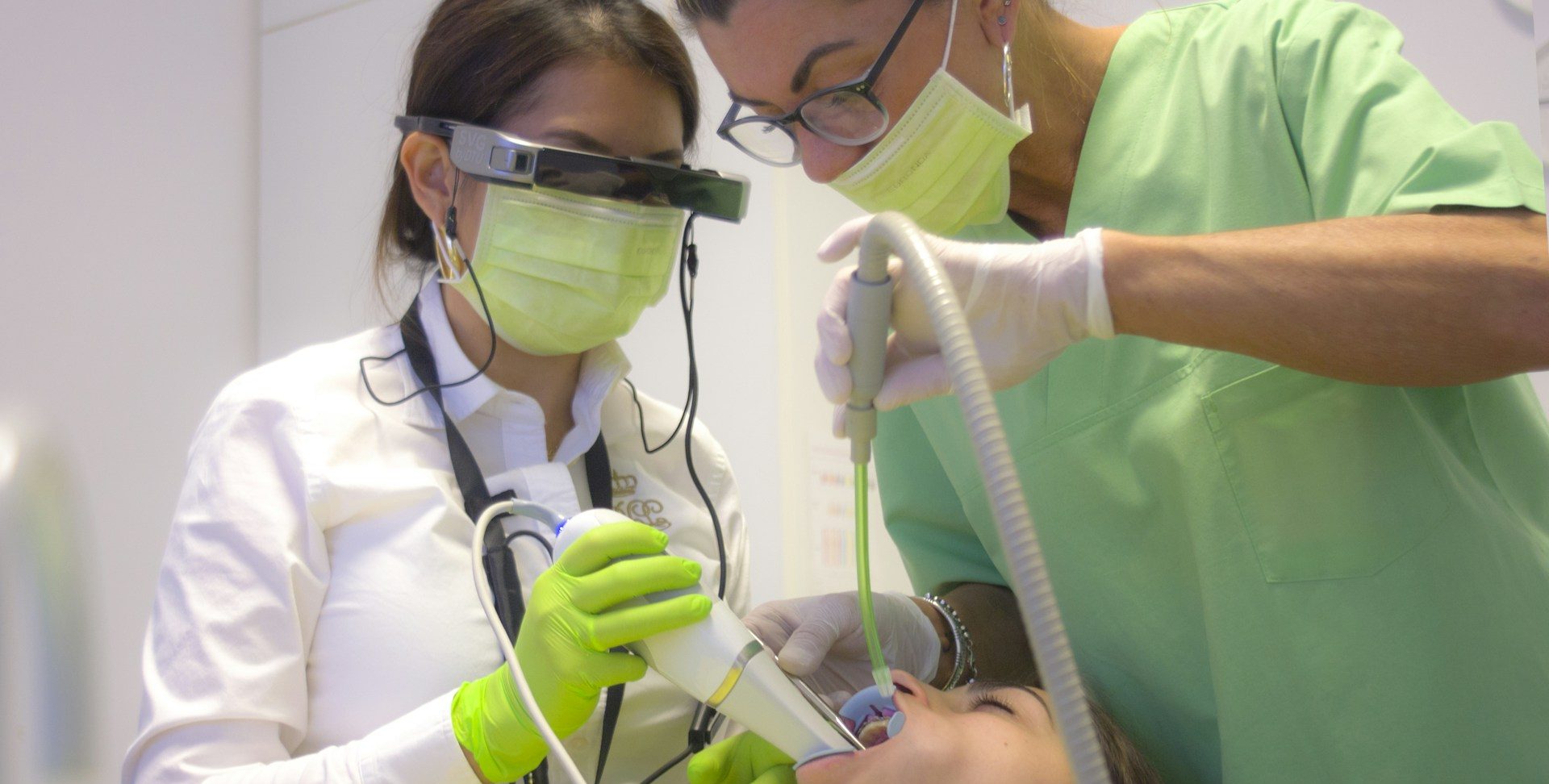Dental Assistant vs Dental Hygienist
Explore the roles of a dental assistant vs a dental hygienist, key players in dental care. This guide highlights their unique contributions, showcasing the skills and dedication they bring to the dental field. Uncover what separates these professions and how they work together to enhance dental health.
Dental Assistant vs Dental Hygienist: Definition, Responsibilities, Education
The dental field boasts various roles essential for providing comprehensive dental care. Understanding the definitions, responsibilities, and educational requirements of a dental hygienist vs dental assistant is key to appreciating their roles in promoting oral health.
Who Is A Dental Assistant?
Dental assistants are the linchpins of dental practices, ensuring smooth operation through a blend of patient care and administrative duties. Their role encompasses:
- Patient Preparation: Making patients comfortable in the dental chair and preparing them for treatments.
- Instrument Sterilization: Ensuring all dental instruments are sterilized and ready for use.
- Assistance During Procedures: Providing hands-on support to dentists during dental procedures by handling instruments and managing suction devices.
- Administrative Tasks: Scheduling appointments, managing patient records, and handling billing.

Who Is A Dental Hygienist?
Dental hygienists focus on preventive dental care, with responsibilities including:
- Oral Health Assessments: Conduct thorough examinations of patients’ oral health and report findings to dentists, a key distinction in the “dental hygienist vs assistant” comparison.
- Teeth Cleaning: Remove plaque and tartar from teeth to prevent cavities and gum disease.
- Patient Education: Instruct patients on proper oral hygiene techniques and good oral health.
- Preventive Care: Apply sealants and fluorides to protect teeth from decay.

Educational Requirements for Dental Assistants
The path to becoming a dental assistant involves the following:
- Science-Focused High School Education: Emphasis on biology and chemistry.
- Enrollment in Accredited Programs: Completion of a dental assisting program, usually lasting about one year.
- Certification: Obtaining a National Dental Assisting Examination Board certificate for licensure.
Educational Requirements for Dental Hygienists
Dental hygienists must have more extensive education and meet specific certification requirements.
- Complete a Dental Hygiene Program: This can be a diploma or bachelor’s degree program, lasting two to four years.
- Passing the National Dental Hygiene Certification Exam is essential for confirming professional competency.
- Obtain Provincial Licensing: Requirements vary by province, including adherence to ongoing professional development and quality assurance standards.
What Does a Dental Assistant Do?
Dental assistants play a multifaceted role in dental practices, including
- Supporting Dentists: Assisting with dental procedures by providing necessary instruments and materials.
- Patient Care: Comforting patients and explaining procedures to alleviate anxiety.
- Office Management: Handling front office duties, including appointment scheduling and insurance billing.
What Does a Dental Hygienist Do?
Dental hygienists are primarily responsible for
- Conducting Cleanings: Performing professional teeth cleanings to remove plaque and tartar.
- Assessing Oral Health: Conducting oral exams and evaluating patients’ health status.
- Educational Initiatives: Guiding how to improve and maintain good oral dental hygiene practices.
Primary Differences: Dental Assistant vs Hygienist
Exploring the roles of dental hygienists vs dental assistants reveals separate paths and responsibilities within dental care, reminiscent of the complex challenges dental practice owners face.
Educational Divergence
This variance in educational requirements sets the foundation for the differing scopes of practice and responsibilities attributed to each role.
- Dental Assistant:
- Education: Completing an eight-month to one-year program in dental assistance or secondary school plus on-the-job training.
- Licensing: Registration with a regulatory body is required in most provinces. Certification by the National Dental Assisting Examination Board is needed for intra-oral duties in most regions except Quebec.
- Dental Hygienist:
- Education: Completing a dental hygiene diploma or bachelor’s program typically lasts two to four years.
- Licensing: Must pass the National Dental Hygiene Certification Exam and obtain provincial licensing.
Responsibilities
The delineation of tasks underlines the specialized nature of each role, with dental assistants facilitating the smooth operation of dental practices and dental hygienists focusing on direct patient care.
- Dental Assistant Tasks:
- Plays a supportive role during dental procedures.
- Handles administrative tasks and contributes to patient care.
- Dental Hygienist Duties:
- Focuses on providing preventive oral health services.
- Takes an active role in patient education regarding oral hygiene.
Impact on Practice
The distinct contributions of a dental assistant vs a hygienist are pivotal to the success of dental practices, each enhancing patient care and practice operations in unique and valuable ways.
- Dental Assistants are key to maintaining the operational efficiency of dental offices, ensuring that practices run smoothly and efficiently.
- Dental Hygienists profoundly influence patient satisfaction and retention, primarily through their roles in preventive care and patient education.

Dental Assistant vs Dental Hygienist Salary Comparison
The financial landscape of dental professions reveals significant differences between a dental assistant salary and a dental hygienist, reflecting their varying educational requirements and scope of responsibilities.
Dental Assistant Salary Insights
As of 2023, the salary for dental assistants in Canada varies by province, with the mid-range salary around CAD 49,350 in Ontario, while in Alberta, it’s higher at CAD 63,000. Similarly, in British Columbia, the mid-range salary is approximately CAD 54,600.
These figures indicate a healthy demand for dental assistants in various provinces of Canada, with prospects ranging from moderate to good. This information is supported by data and analysis from sources such as the Canadian government’s labor projections and industry-specific job market reviews.
Dental Hygienist Salary Overview
As of 2023, the salary for dental hygienists in Canada varies significantly by province:
- In Ontario, as of 2023, dental hygienists earn an average hourly wage of around $46, according to the Ontario Dental Hygienists’ Association and Indeed, which aligns with Canada’s higher national averages.
- Quebec: In Quebec, the salary range for dental hygienists is between $52,500 and $84,000 annually. The mid-range salary here is $67,200. Montreal and Quebec City both have mid-range wages of $67,200.
- Alberta: Alberta offers a wider salary range, from $44,100 to $126,000, with a mid-range salary of $115,500, significantly higher than the national mid-range salary.
- Canada-wide Hourly Wages: Across Canada, the hourly wages for dental hygienists vary, with a low of $30, a median of $40, and a high of $55.83.
Understanding the Gap
The noticeable dental assistant vs dental hygienist salary gap can be attributed to the following factors:
- Extended Educational Path: Dental hygienists typically complete extensive education, ranging from two to four years for a diploma or bachelor’s degree. Dental assistants, on the other hand, usually have shorter training, often around eight months to a year, or they may receive training directly on the job.
- Scope of Practice: Dental hygienists have a broader and more specialized practice, often working independently to perform cleanings, assessments, and patient education.
- Clinical Responsibilities: The direct clinical responsibilities and expertise required for dental hygienists justify their higher earnings than dental assistants, who primarily support dentists and manage office tasks.
Future Trends in Dental Assisting and Hygiene
The future of dental assistance and hygiene is on the cusp of significant transformation, driven by technological advancements, shifting patient expectations, and a growing focus on preventive care. Here are some key trends shaping these fields:
- Medical-Dental Integration: There’s a significant movement towards integrating dental care with overall body health. Dental hygienists are increasingly recognized as key healthcare providers, playing a role in understanding and treating conditions linked to oral health, such as heart health and diabetes.
- Interprofessional Education: Future dental hygienists are expected to receive inter-professional education, interacting with nursing professionals and other healthcare providers. This trend reflects the interconnected nature of healthcare today.
- New Technologies and Treatments: Emerging technologies like artificial intelligence are being integrated into dental hygiene practices. This and alternative treatments like probiotics and laser therapy will enhance patient care further.

Tempfind: Revolutionizing Dental Temporary Staffing
How Tempfind Works
Tempfind introduces an innovative approach to temporary dental staffing, namely dental assistant jobs and dental hygienist jobs. We streamline the connection between dental clinics and skilled professionals seeking temporary positions. The platform operates on a simple yet effective mechanism:
- Profile Creation: Dental professionals create profiles showcasing their qualifications, experience, and availability. Similarly, dental clinics register and outline their staffing needs.
- Matching Algorithm: Utilizing advanced algorithms, Tempfind matches dental clinics with the most suitable dental professionals. This process considers skill sets, location preferences, and availability.
- Feedback System: After completing the temporary position, clinics and professionals can leave feedback, ensuring continuous improvement and quality assurance.
Benefits for Dental Clinics
Tempfind offers numerous advantages to dental clinics:
- Flexibility: Allows clinics to fill staffing gaps quickly without the long-term commitment of hiring permanent staff.
- Cost-Effective: Reduces the overhead costs of recruiting and vetting temporary staff.
- Access to Skilled Professionals: Clinics have access to a wide pool of vetted dental professionals, ensuring quality care for patients.
- Time Savings: Automates the staffing process, saving time to hire dental assistant that can be spent treating patients.
Benefits for Dental Professionals
For dental professionals, Tempfind offers:
- Varied Opportunities: Access to various temporary positions, providing exposure to different clinical environments.
- Schedule Control: Professionals can choose assignments that fit their schedule, providing work-life balance.
- Skill Enhancement: Opportunities to work in different settings, enhancing skills and experience.
- Networking: Builds a network within the dental community, opening doors for future opportunities.
Frequently Asked Questions
Are there specific certifications required for dental assistants?
Dental assistants generally require specific certifications to practice. These include completing a dental assistance program and registration with a regulatory body in most provinces except Quebec and Ontario. National Dental Assisting Examination Board (NDAEB) certification accreditation is also necessary for performing intra-oral duties in all regions except Quebec.
Can a dental hygienist perform the duties of a dental assistant?
A dental hygienist can perform the duties of a dental assistant. However, their role is generally more advanced, focusing on patient care, oral hygiene, and preventive dental services. Hygienists are often more qualified than dental assistants and can perform a broader range of tasks.
How does Tempfind help dental clinics connect with temporary dental professionals?
Tempfind helps dental clinics connect with temporary dental professionals by:
- Online Platform: Utilizes a digital platform for connection.
- Matching: Matches clinics with qualified professionals based on specific needs.
- Scheduling Ease: Streamlines the process of finding and scheduling temporary staff.
Do dental assistants and dental hygienists work together in a clinical setting?
Dental assistants and dental hygienists often work together in a clinical setting. While their roles differ, they collaborate to provide patient care. Assistants typically handle preparatory and supportive tasks, whereas hygienists focus more on direct patient care and preventive treatments.
How long does it take to become a dental assistant or dental hygienist?
Dental assistant vs dental hygienist schooling may differ depending on the province:
- Dental Assistant:
- Timeframe: A few months to one year.
- Program Length: Varies based on the program and province requirements.
- Dental Hygienist:
- Dental hygiene diploma: Approximately two to four years.
- Further Education: Options for bachelor’s or master’s degrees are available.




